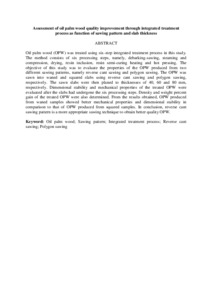Citation
Hamzah, Nurul Nabilah and Bakar, Edi Suhaimi and Ashaari, Zaidon and Lee, Seng Hua
(2017)
Assessment of oil palm wood quality improvement through integrated treatment process as function of sawing pattern and slab thickness.
Journal of Oil Palm Research, 29 (3).
366 - 372.
ISSN 1511-2780
Abstract
Oil palm wood (OPW) was treated using six-step integrated treatment process in this study. The method consists of six processing steps, namely, debarking-sawing, steaming and compression, drying, resin inclusion, resin semi-curing heating and hot pressing. The objective of this study was to evaluate the properties of the OPW produced from two different sawing patterns, namely reverse cant sawing and polygon sawing. The OPW was sawn into waned and squared slabs using reverse cant sawing and polygon sawing, respectively. The sawn slabs were then planed to thicknesses of 40, 60 and 80 mm, respectively. Dimensional stability and mechanical properties of the treated OPW were evaluated after the slabs had undergone the six processing steps. Density and weight percent gain of the treated OPW were also determined. From the results obtained, OPW produced from waned samples showed better mechanical properties and dimensional stability in comparison to that of OPW produced from squared samples. In conclusion, reverse cant sawing pattern is a more appropriate sawing technique to obtain better quality OPW.
Download File
![[img]](http://psasir.upm.edu.my/60946/1.hassmallThumbnailVersion/Assessment%20of%20oil%20palm%20wood%20quality%20improvement%20through%20integrated%20treatment%20process%20as%20function%20of%20sawing%20pattern%20and%20slab%20thickness.pdf)  Preview |
|
Text (Abstract)
Assessment of oil palm wood quality improvement through integrated treatment process as function of sawing pattern and slab thickness.pdf
Download (5kB)
| Preview
|
|
Additional Metadata
Actions (login required)
 |
View Item |

